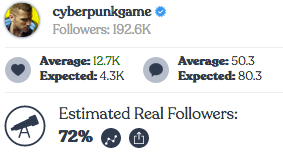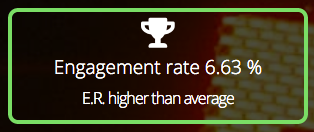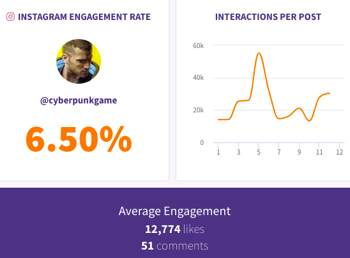WHO ARE ‘INFLUENCERS’ ?
If you are here, you probably heard the term „influencers”. Or if you are one of those pure souls in this world who did not stumble upon this term, let me explain this phenomenon. Speaking plainly, people have been named influencers in this day and age, because of a high number of followers they gathered on social media. Nowadays marketers can use the reach of influencers. To promote a product or a service, their audience might be interested in. Making a deal with micro or macro-influencers can be a really lucrative endeavor for companies or a straight out waste of money.
Recently, the public learned about how many followers of celebrity influencers are fake. Numbers are high, from one third to almost half. As you can imagine influencers with fewer followers, and even small micro-influencers are not an exception to the rule. Fake followers are like a plague, everyone who has an account on Instagram has some of them,
BUYING FOLLOWERS
When most people see somebody have millions or thousands of followers, they subconsciously assume that influencer’s high status. People who buy fake followers mistakenly think they discovered a shortcut to success. In reality, buying followers is a long term disaster, a high number of fake followers makes your audience worthless. Why? Data is the answer, targeting a direct campaign at your current (fake)audience is pointless as well as searching for lookalike’s based on the audience. In short words, the data will be corrupted, making any conversion(e.g. sale) practically impossible. Any action like a “shoutout” paid posts is meaningless, if any agency or brand decides to work with that kind of influencer.
ON THE LOOKOUT
While looking for an influencer for a product campaign, you need to be guided by the category of your product and how much compatibility is there between it
Next thing is influencer’s expertise and how authentic they are in their own niche. In essence, is the content helpful for people, or is every second post a plain paid advertisement. If it’s the latter, their followers are already tired of seeing sponsored posts, and throwing another deal their way won’t do any good for any business. On top of that check how frequently influencer is interacting with his audiences, is he doing any polls, quizzes, does he reply to people’s comments.
When influencer ticks all the boxes we’re set to go, right? Not yet, the fun is yet to start. You need to identify how really influential, the influencer is!
SIGNS OF FAKE-NESS
So how to spot red flags, you might ask? Below are tips and tools that will help you identify them.
Number of followers and sudden spikes of followers growth
Starting with a strange gap between a number of followers and likes suggest followers might be acquired non-organically through 3rd party sites, meaning straight out bought overnight. For example account with 100k followers on average only have few comments and a hundred likes, no bueno. That’s why you don’t let followers count fool you!
Bots
Looking for high engagement rate is your main goal, but beware, it might be artificial. When you see generic-sounding comments with no real context to posted content, those are usually likely to be bots.
Gambling the algo
On the other hand, people learned to gamble algorithm in the way they might even be featured on explore page in a matter of minutes. The idea is to get likes from pages with high followers count, that way algorithm thinks this particular piece of content people will love to see.
How people are doing it? They usually barter likes for likes, inside either special whats up groups or Instagram group chats. The only thing required for this barter to work is to have at least one account with high followers count. Getting likes and comments on your post from accounts with a large number of followers is a huge boost, Instagram algorithm loves that. So, you simply ask people in the group for likes on your recent post, you link it with a name of your account with at least ~10k followers, as a confirmation you are going to return the favor in near future. When you see those kinds of comments below posts made mostly by huge accounts, it means there are artificially boosting themselves for higher engagement rate.
TOOLS OF THE TRADE
To help you analyze we need to go deeper, thankfully there are tools online at your disposal.
IG Audit (free)

Calculates estimated real followers percentage, based on the quality of followers as well as statistics like comments per like, comments per post.
Social Blade (free + paid)
The most famous tool lets you check statistics across almost all social platforms. The main thing you will do is looking at historical data for sudden spikes in followers number over a short period.
Hype Auditor (free + paid)

Uses AI to find behavior patterns that correspond with real people vs automated bots or sporadic usage.
Ninjalitics (free + paid)

Gives a bunch of insights about Instagram account including calculated engagement rate.
Phlanx Engagment Calculator (free + paid)

Plain simple Instagram engagement calculator.
MEASURING ENGAGEMENT RATE YOURSELF
There are many options for calculating engagement rate by yourself, we will focus on one of them for public posts. Before you start, know that you should skip at least first three posts, because they still might get likes and comments which can distort the final rate.

By using this method you divide the total number of likes with added comments by the number of followers. Then multiply the result by 100 to get the percentage rate. That is the influencer’s engagement rate. These numbers tend to change over time but for now, engagement rate above 3% is pretty great, but might be inflated artificially, while the rate below 2% is just not enough.
FINAL THOUGHTS
Are Instagram influencers overrated? To a degree yes, more and more of them are using not quite legit methods to look like they have a tremendous influence and reach. This is why lately, micro-influencer became popular, they usually have higher engagement rate because of the smaller pool of followers, but that’s why it is easier for an influencer to connect with their dedicated fans. Which is even more favorable
To recap, don’t get fooled by a large number of followers. It doesn’t really mean anything. Look through comments for fake contextless comments made by bots, as well as comments made by other influencers, who might be using the trick for boosting posts in the eyes of the algorithm. When following these steps and using tools, spotting fake influencers should be a breeze. Search for an influencer who’s connected with his audience and is building a genuine personal brand, through quality content.





